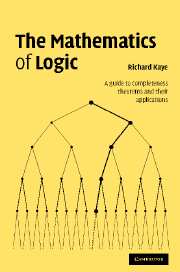Book contents
- Frontmatter
- Contents
- Preface
- How to read this book
- 1 König's Lemma
- 2 Posets and maximal elements
- 3 Formal systems
- 4 Deductions in posets
- 5 Boolean algebras
- 6 Propositional logic
- 7 Valuations
- 8 Filters and ideals
- 9 First-order logic
- 10 Completeness and compactness
- 11 Model theory
- 12 Nonstandard analysis
- References
- Index
2 - Posets and maximal elements
Published online by Cambridge University Press: 28 January 2010
- Frontmatter
- Contents
- Preface
- How to read this book
- 1 König's Lemma
- 2 Posets and maximal elements
- 3 Formal systems
- 4 Deductions in posets
- 5 Boolean algebras
- 6 Propositional logic
- 7 Valuations
- 8 Filters and ideals
- 9 First-order logic
- 10 Completeness and compactness
- 11 Model theory
- 12 Nonstandard analysis
- References
- Index
Summary
Introduction to order
The idea of an order is central to many kinds of mathematics. The real numbers are familiarly ordered as a number–line, and even a collection of sets will be seen to be partially ordered by the ‘subset of’ relation. We shall start by presenting the axioms for a partially ordered set and then discuss one particularly interesting question about such sets, whether they have maximal elements.
An order relation is a relation R between elements x, y of some set X, where xRy means x is smaller than or comes before y. An alternative notation arises when one thinks of the relation more concretely as a set of pairs (x, y), a subset of X2 = {(x, y) : x, y ∈ X}. We can then write xRy in an alternative way as (x, y) ∈ R.
Definition 2.1 A partial order on a set X is a relation R ⊆ X2 such that
(i) (x, y) ∈ R and (y, z) ∈ R implies (x, z) ∈ R
(ii) (x, x) ∉ R
for all x, y ∈ X.
Example 2.2 The relation on the set of real numbers ℝ defined by ‘(x, y) ∈ R if and only if x < y’ is a partial order, where < is the usual order on the set of real numbers. In fact it is a special kind of partial order that we will later call a total order or linear order.
Information
- Type
- Chapter
- Information
- The Mathematics of LogicA Guide to Completeness Theorems and their Applications, pp. 11 - 23Publisher: Cambridge University PressPrint publication year: 2007
